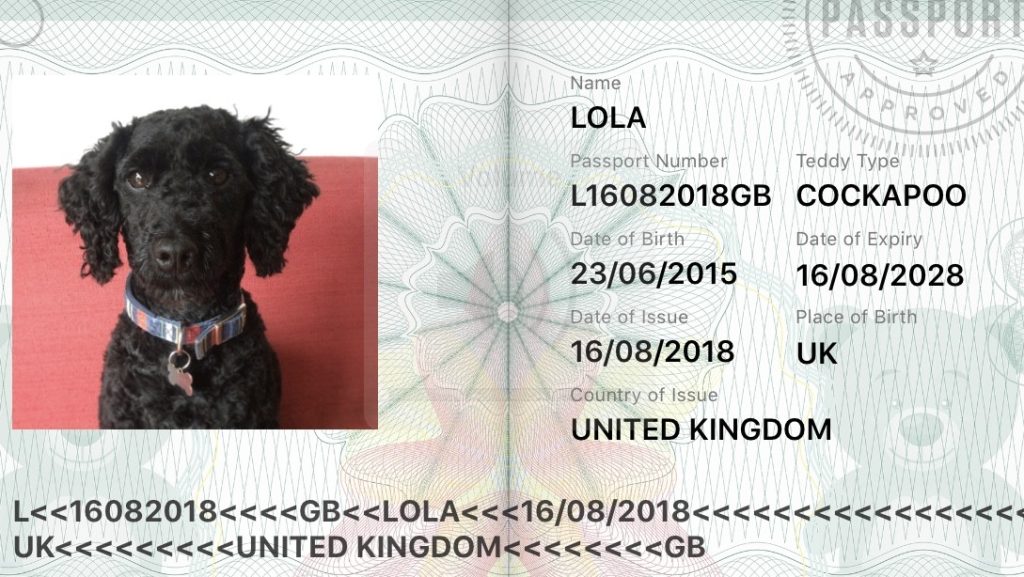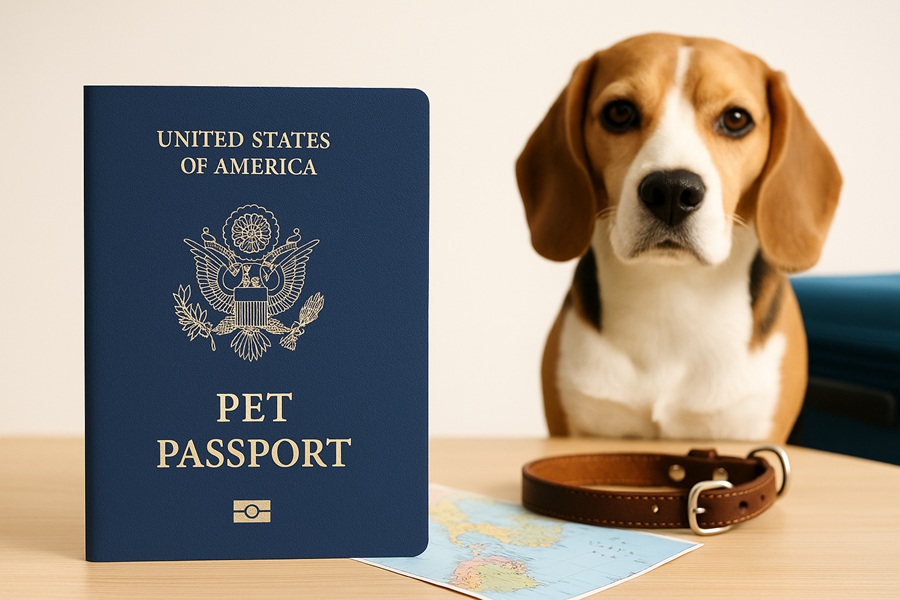🐾 Pet Passport – When Is It Necessary?
If you’re planning to travel abroad with your beloved cat or dog, one of the first things you’ll hear about is a pet passport. But what exactly is a pet passport, why do pets need one, and when is it truly necessary?
Much like human passports, a pet passport is an essential identification and health document that allows your furry friend to cross international borders legally and safely. It ensures that your pet is healthy, properly vaccinated, and complies with the destination country’s import requirements.
In this article, we’ll explain everything you need to know about pet passports — including when you need one, how to get it, what documents are required, and how it helps make your pet’s journey stress-free and compliant with international travel laws.
1. What Is a Pet Passport?

A pet passport is an official veterinary document that records important information about your animal’s identity, vaccinations, and health status.
It’s designed to simplify pet travel between countries, helping authorities verify that your pet meets health and quarantine standards.
A typical pet passport includes:
-
Pet’s identification details (name, breed, color, sex, date of birth)
-
Microchip number or tattoo ID
-
Rabies vaccination certificate
-
Health check records from a licensed veterinarian
-
Parasite treatment records (tick, tapeworm)
-
Owner’s contact information
-
Official veterinary signature and stamp
Some passports also include:
-
Photos of the pet
-
Details of previous travels or import/export stamps
-
Laboratory test results (such as rabies antibody titers)
🐶 Note: The term “pet passport” originally came from the European Union Pet Travel Scheme (PETS), but today it’s used more broadly to describe international travel documents for pets worldwide.
2. When Do Pets Need a Passport?
The need for a pet passport depends on where you’re traveling and how your pet is being transported.
Here are common situations when a pet passport is necessary:
2.1. Traveling Internationally
Whenever your pet crosses an international border — whether for vacation, relocation, study abroad, or adoption — a pet passport or equivalent health document is required.
Most countries will not allow entry without:
-
A valid rabies vaccination certificate
-
Microchip identification
-
A veterinary health certificate issued shortly before travel
For example:
-
Traveling from Vietnam to the EU or UK requires a full pet passport with rabies antibody test results.
-
Traveling from the US to Canada may only require proof of rabies vaccination and a health certificate.
2.2. When Returning Home
Even if you’re returning to your home country after a trip, your pet must still comply with re-entry requirements — including quarantine in some cases.
Having a valid pet passport simplifies the process and helps you avoid delays or denial at customs.
2.3. When Transiting (Layovers)
If your pet’s flight includes a transit stop in another country, some airports (like Singapore, Japan, or the UK) require the pet’s documents to meet their local entry standards, even if it’s just a layover.
Without a proper pet passport, the airline may refuse boarding or delay your pet’s transfer.
2.4. For Permanent Relocation
When moving abroad for work, study, or emigration, your pet’s passport serves as official proof of health and ownership.
It’s required for:
-
Import permits
-
Customs clearance
-
Pet quarantine release
3. Why Is a Pet Passport Important?
A pet passport isn’t just a travel document — it’s also a safety measure for your animal, other passengers, and the ecosystem of the destination country.
Here’s why it matters:
✅ 3.1. Prevents the Spread of Disease
The primary goal of a pet passport is to control diseases like rabies, which can be fatal to both animals and humans.
Countries like Australia, Japan, and New Zealand have strict import rules to keep rabies-free status. A pet passport helps authorities verify vaccination history.
✅ 3.2. Ensures Smooth Customs Clearance
Without a pet passport, customs may delay, quarantine, or even deny entry for your pet.
With a complete and valid passport, the inspection process becomes faster and simpler, avoiding unnecessary stress for both owner and animal.
✅ 3.3. Proves Legal Ownership
The passport includes your name and contact details, serving as official proof that the pet belongs to you — crucial in cases of theft, loss, or disputes.
✅ 3.4. Reduces Quarantine Time
Some countries allow pets with valid passports and rabies antibody tests to skip or shorten quarantine periods.
For instance, in the EU, pets entering from approved countries can travel freely without quarantine if they have an up-to-date pet passport.
4. What Documents Are Included in a Pet Passport Application?
To obtain a pet passport, you’ll typically need the following:
| Document | Description |
|---|---|
| Microchip certificate | Proof that your pet is microchipped before rabies vaccination |
| Rabies vaccination certificate | Must be issued after microchipping, valid for 1–3 years depending on vaccine type |
| Health certificate | Issued by an accredited vet 3–10 days before travel |
| Rabies antibody test (if required) | Conducted at an approved laboratory at least 30 days after vaccination |
| Internal and external parasite treatment records | Proof of deworming and flea/tick prevention within a specific timeframe |
| Import/export permits | Depending on the destination country’s regulations |
5. How to Get a Pet Passport – Step-by-Step Guide

Here’s a general guide on how to get your pet’s passport and travel documents:
Step 1: Microchip Your Pet
Before anything else, your pet must have a 15-digit ISO 11784/11785 microchip implanted.
This chip links to your pet’s medical record and serves as a unique identifier recognized globally.
Step 2: Rabies Vaccination
Once microchipped, your pet must be vaccinated against rabies.
If it’s the first rabies shot, most countries require a 21–30 day waiting period before travel.
Step 3: Rabies Antibody (Titer) Test
For destinations like the EU, UK, or Japan, your pet must pass a blood test proving sufficient rabies antibodies (≥0.5 IU/ml).
This test is conducted at an approved lab, and results are valid for several years.
Step 4: Obtain a Health Certificate
Within 7–10 days before departure, visit an authorized veterinarian to get a health certificate confirming your pet is fit to travel and free of contagious diseases.
Step 5: Apply for the Pet Passport
Your vet or local animal quarantine office will compile all documents into an official pet passport booklet or certificate package, complete with stamps and signatures.
Step 6: Verify Country-Specific Rules
Always check the destination’s import requirements, as rules vary widely:
-
The EU accepts a standardized EU Pet Passport.
-
Non-EU countries issue national veterinary certificates.
-
Some countries require quarantine or import permits in advance.
6. Common Mistakes to Avoid When Getting a Pet Passport
| Mistake | Consequence |
|---|---|
| Vaccinating before microchipping | Vaccination becomes invalid |
| Missing antibody test | Entry denied or quarantine required |
| Using non-accredited veterinarian | Documents rejected at customs |
| Waiting too close to departure | Not enough time for testing or approval |
| Incomplete forms or missing stamps | Delays, fines, or denied boarding |
To avoid these issues, it’s best to start the pet passport process at least 2–3 months before your travel date.
7. Do All Countries Require a Pet Passport?
No — not all countries issue or require an official “pet passport” booklet.
However, every country requires some form of health and vaccination documentation.
Here’s a quick comparison:
| Destination | Requires Pet Passport | Additional Requirements |
|---|---|---|
| European Union (EU) | ✅ Yes | Must meet EU Pet Travel Scheme rules |
| United Kingdom | ✅ Yes | Rabies antibody test required |
| USA / Canada | ❌ No | Health certificate and rabies proof |
| Australia / New Zealand | ❌ No | Strict import permit, long quarantine |
| Japan / Singapore | ❌ No | Advance notification, rabies test, quarantine possible |
| Vietnam / Thailand | ❌ No | Veterinary certificate and microchip proof |
In short, even if your destination doesn’t issue a formal “pet passport,” your pet still needs equivalent documents for customs clearance.
8. Tips for Smooth Pet Travel with a Passport
-
📋 Check airline regulations: Each airline has its own pet travel policy (IATA standards apply).
-
🧳 Use an IATA-approved travel crate: The cage must meet international standards for size, ventilation, and safety.
-
⏱️ Start preparations early: Some tests and permits take several weeks.
-
🧠 Train your pet for the journey: Help your pet get used to the crate before the flight.
-
🧑⚕️ Consult a vet: Make sure your pet is fit to travel, especially for long-haul flights.
9. Conclusion
A pet passport is far more than just paperwork — it’s your pet’s ticket to a safe and legal international journey.
It proves that your animal companion is healthy, vaccinated, and properly identified, ensuring smooth entry through customs and reducing the risk of quarantine or travel refusal.
If you plan to travel abroad, relocate, or even transit through another country, make sure you understand when and why your pet needs a passport.
Start the process early, double-check destination requirements, and work with certified veterinarians or professional pet transport services.
With the right preparation, your pet can explore the world by your side — safely, happily, and without any border troubles. 🌍🐾
Read more:
- Những rủi ro khi vận chuyển thú cưng không đúng quy định
- Pet Safety During Transit (Layover) – What Should You Do?

